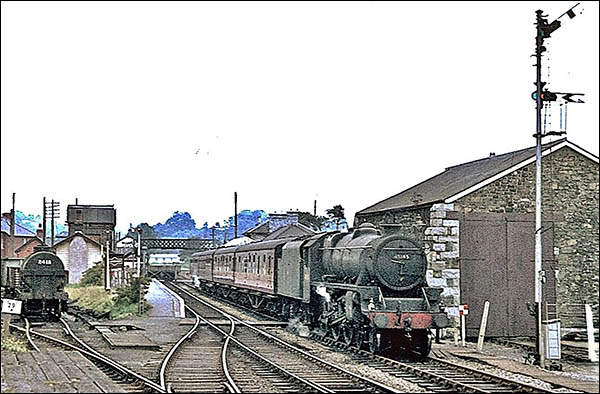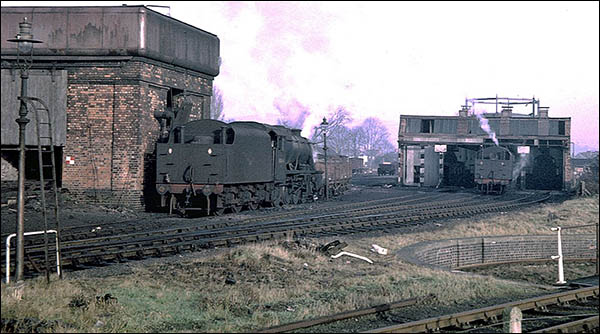Llandovery railway station
Llandovery was a major centre for droving until the spread of the railway network mechanised the transport of livestock. This change was symbolised by the cattle pens south of Llandovery station, where animals had their own platform to board trains! The 1960s photos were taken by John Davies – see the footnotes for details.
Llandovery station opened in 1858 as the terminus of a new railway from Llandeilo. A small engine shed stood north-west of the station. In 1868 the London & North Western Railway (LNWR) opened an extension from Llanwrtyd to Llandovery, completing a route from northern England to Swansea.
 The climb from Llandovery to Sugar Loaf summit was so arduous for steam engines that another locomotive, known as a “banker”, gave a helping push to most northbound trains from here. The LNWR built a bigger engine shed south of the station, where the banker and other locos were based. The Great Western Railway kept the original engine shed for the loco used on its Llandovery to Llanelli service.
The climb from Llandovery to Sugar Loaf summit was so arduous for steam engines that another locomotive, known as a “banker”, gave a helping push to most northbound trains from here. The LNWR built a bigger engine shed south of the station, where the banker and other locos were based. The Great Western Railway kept the original engine shed for the loco used on its Llandovery to Llanelli service.
A siding opposite the cattle pens supplied coal to Llandovery gasworks. Gas produced by burning the coal was piped under roads for lighting.
Evidence from an 1875 court case gives an insight into the transition from droving to rail transport. The RSPCA charged a pig dealer with causing unnecessary pain to pigs sent from Llandovery to Merthyr Tydfil via the 5.05pm train on fair day. The LNWR’s cattle inspector estimated 70 to 80 pigs in one wagon, when two wagons should have been paid for. Other witnesses said there were 43 pigs. Llandovery stationmaster David Williams admitted the pigs weren’t counted by a railway servant because the station was busy that day. Magistrates dismissed the case and urged better supervision by railway companies.
 In 1929 engine driver Arthur Seabury, 58, suffered head wounds after a Mr Griffiths left open a cattle wagon’s swing door at Llandovery. Arthur hit the door as he looked out from his cab while driving along the adjacent track.
In 1929 engine driver Arthur Seabury, 58, suffered head wounds after a Mr Griffiths left open a cattle wagon’s swing door at Llandovery. Arthur hit the door as he looked out from his cab while driving along the adjacent track.
Droving within Wales continued until the rapid growth of motor cars and lorries in the 1930s. In 1916 cattle drover Walter Ayres had to be put in a train compartment by himself at Llandovery station because he was so drunk and abusive.
Llandovery’s engine sheds and sidings were removed in the 1960s. The station retains its historic building and its passing loop for trains going in opposite directions on the scenic Heart of Wales line. In February 2025 Transport for Wales introduced the first of the line’s six “active travel” trains, each with space for 10 bicycles.
With thanks to the Railway Work, Life & Death project for accident information, and to John Davies
Postcode: SA20 0BG View Location Map
Railway Work, Life & Death website
Footnotes: What the photos show
The upper photo shows a Shrewsbury to Swansea Victoria service leaving Llandovery in February 1963. It was taken from the platform where livestock was loaded into trains. On the right is the goods shed where railway wagons were loaded or unloaded under cover.
The lower photo shows the former LNWR engine shed in January 1964, shortly before closure. The two ‘8F’ locos were based there for banking trains. Locos received coal and water from the structure on the left. In the bottom right is part of the pit of the turntable, where locos could be rotated to face the direction of their next journey.




